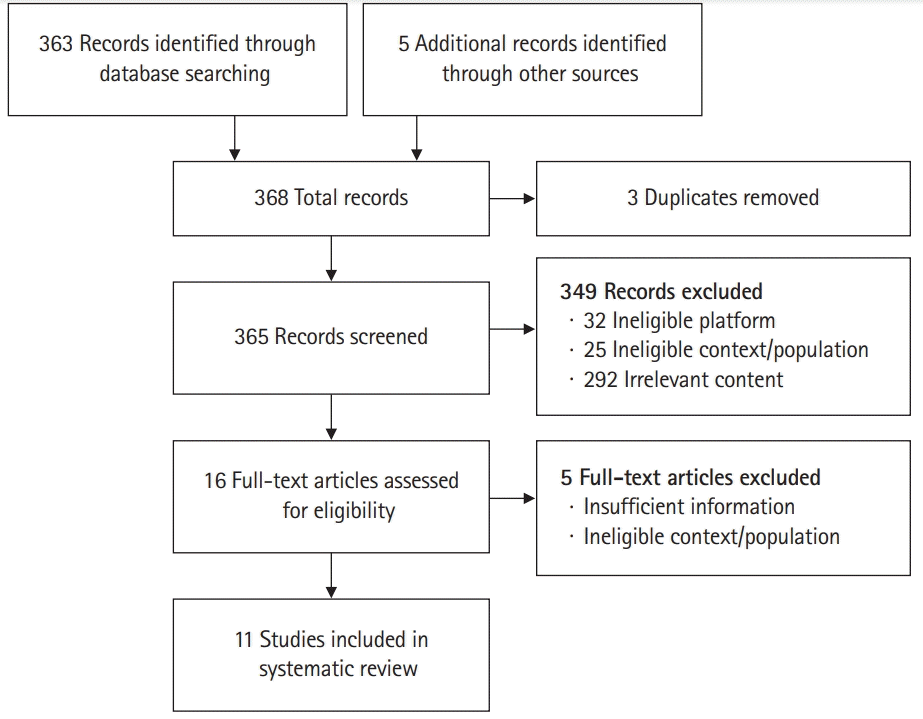1. Lockyer J, Carraccio C, Chan MK, Hart D, Smee S, Touchie C, Holmboe ES, Frank JR; ICBME Collaborators. Core principles of assessment in competency-based medical education. Med Teach. 2017; 39:609–616.
https://doi.org/10.1080/0142159X.2017.1315082.

3. Quinlin L, Clark Graham M, Nikolai C, Teall AM. Development and implementation of an e-visit objective structured clinical examination to evaluate student ability to provide care by telehealth. J Am Assoc Nurse Pract. 2020; 33:359–365.
https://doi.org/10.1097/JXX.0000000000000409.

4. Tricco AC, Lillie E, Zarin W, O’Brien KK, Colquhoun H, Levac D, Moher D, Peters MDJ, Horsley T, Weeks L, Hempel S, Akl EA, Chang C, McGowan J, Stewart L, Hartling L, Aldcroft A, Wilson MG, Garritty C, Lewin S, Godfrey CM, Macdonald MT, Langlois EV, Soares-Weiser K, Moriarty J, Clifford T, Tunçalp O, Straus SE. PRISMA Extension for Scoping Reviews (PRISMA-ScR): checklist and explanation. Ann Intern Med. 2018; 169:467–473.
https://doi.org/10.7326/M18-0850.

5. Webb EA, Davis L, Muir G, Lissauer T, Nanduri V, Newell SJ. Improving postgraduate clinical assessment tools: the introduction of video recordings to assess decision making. Med Teach. 2012; 34:404–410.
https://doi.org/10.3109/0142159X.2012.668242.

6. Chan J, Humphrey-Murto S, Pugh DM, Su C, Wood T. The objective structured clinical examination: can physician-examiners participate from a distance? Med Educ. 2014; 48:441–450.
https://doi.org/10.1111/medu.12326.

7. Watson P, Stevenson M, Hawkins S. Neurology assessment by objective structured video examination. Clin Teach. 2016; 13:348–351.
https://doi.org/10.1111/tct.12443.

8. Isaak R, Stiegler M, Hobbs G, Martinelli SM, Zvara D, Arora H, Chen F. Comparing real-time versus delayed video assessments for evaluating ACGME sub-competency milestones in simulated patient care environments. Cureus. 2018; 10:e2267.
https://doi.org/10.7759/cureus.2267.

9. Lara S, Foster CW, Hawks M, Montgomery M. Remote assessment of clinical skills during COVID-19: a virtual, high-stakes, summative pediatric objective structured clinical examination. Acad Pediatr. 2020; 20:760–761.
https://doi.org/10.1016/j.acap.2020.05.029.

10. Shehata MH, Kumar AP, Arekat MR, Alsenbesy M, Mohammed Al Ansari A, Atwa H, Ahmed SA, Deifalla A. A toolbox for conducting an online OSCE. Clin Teach. 2021; 18:236–242.
https://doi.org/10.1111/tct.13285.

11. Baribeau DA, Mukovozov I, Sabljic T, Eva KW, deLottinville CB. Using an objective structured video exam to identify differential understanding of aspects of communication skills. Med Teach. 2012; 34:e242–e250.
https://doi.org/10.3109/0142159X.2012.660213.

12. Nickel F, Hendrie JD, Stock C, Salama M, Preukschas AA, Senft JD, Kowalewski KF, Wagner M, Kenngott HG, Linke GR, Fischer L, Muller-Stich BP. Direct observation versus endoscopic video recording-based rating with the objective structured assessment of technical skills for training of laparoscopic cholecystectomy. Eur Surg Res. 2016; 57:1–9.
https://doi.org/10.1159/000444449.

15. House JB, Dooley-Hash S, Kowalenko T, Sikavitsas A, Seeyave DM, Younger JG, Hamstra SJ, Nypaver MM. Prospective comparison of live evaluation and video review in the evaluation of operator performance in a pediatric emergency airway simulation. J Grad Med Educ. 2012; 4:312–316.
https://doi.org/10.4300/JGME-D-11-00123.1.

18. Khamisa K, Halman S, Desjardins I, Jean MS, Pugh D. The implementation and evaluation of an e-Learning training module for objective structured clinical examination raters in Canada. J Educ Eval Health Prof. 2018; 15:18.
https://doi.org/10.3352/jeehp.2018.15.18.

19. Sanchez-Ferrer F, Ramos-Rincon JM, Grima-Murcia MD, Luisa Sanchez-Ferrer M, Sanchez-Del Campo F, Compan-Rosique AF, Fernandez-Jover E. Utility of eye-tracking technology for preparing medical students in Spain for the summative objective structured clinical examination. J Educ Eval Health Prof. 2017; 14:27.
https://doi.org/10.3352/jeehp.2017.14.27.

20. Chong L, Taylor S, Haywood M, Adelstein BA, Shulruf B. The sights and insights of examiners in objective structured clinical examinations. J Educ Eval Health Prof. 2017; 14:34.
https://doi.org/10.3352/jeehp.2017.14.34.

22. Chong L, Taylor S, Haywood M, Adelstein BA, Shulruf B. Examiner seniority and experience are associated with bias when scoring communication, but not examination, skills in objective structured clinical examinations in Australia. J Educ Eval Health Prof. 2018; 15:17.
https://doi.org/10.3352/jeehp.2018.15.17.

23. Wilhelm O, Hildebrandt A, Manske K, Schacht A, Sommer W. Test battery for measuring the perception and recognition of facial expressions of emotion. Front Psychol. 2014; 5:404.
https://doi.org/10.3389/fpsyg.2014.00404.

24. Moher D, Liberati A, Tetzlaff J, Altman DG; PRISMA Group. Preferred reporting items for systematic reviews and meta-analyses: the PRISMA statement. PLoS Med. 2009; 6:e1000097.
https://doi.org/10.1371/journal.pmed.1000097.






 PDF
PDF Citation
Citation Print
Print




 XML Download
XML Download